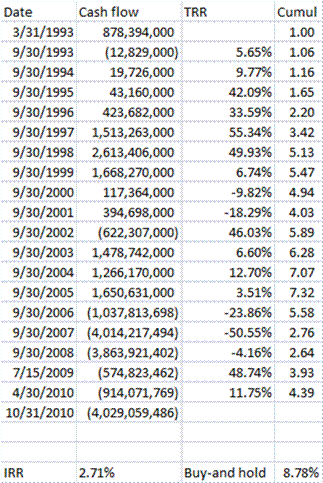Why do we do time-weighted returns for analysis of portfolios?? Because we are lazy, and they are simple to calculate.? We don’t want to be bothered with the effects of cash flows.
Besides, mutual fund managers don’t make decisions to move money in and out of their funds.? They should not be held accountable for the actions of their shareholders.
Really?? I think that is only half correct.? The good fund manager takes account of his implicit liability structure.? When will people leave, when will they come?? For almost all funds, investors are trend followers.? And the the greater the degree of volatility, the worse the investors are at following the trend.? Thus a manager of a volatile fund should run with more of a cash buffer, particularly when markets are moving down hard, because he will have more of his clients cashing out.? The manager of a volatile fund should also avoid taking concentrated positions, because when he is doing well, his own buying may drive the stocks he owns up, only to see them fall harder when he is forced to liquidate positions when the market is doing poorly, and shareholders are leaving.? Wise managers concentrate near bottoms, and diversify near tops.
 Now for my poster child, the Legg Mason Value Trust.? Bill Miller is a very intelligent guy, and has a very talented staff.? My main criticism of his management is that it neglects the core concept of value investing, which is “margin of safety.”? The core concept is not cheapness, or as Bill Miller was fond of saying “lowest average cost wins.”
Now for my poster child, the Legg Mason Value Trust.? Bill Miller is a very intelligent guy, and has a very talented staff.? My main criticism of his management is that it neglects the core concept of value investing, which is “margin of safety.”? The core concept is not cheapness, or as Bill Miller was fond of saying “lowest average cost wins.”
Legg Mason Value Trust enthused investors as they racked up significant returns in the late 90s, and the adulation persisted through 2006.? As Legg Mason Value Trust grew larger it concentrated its positions.? It also did not care much about margin of safety in financial companies.? It bought cheap, and suffered as earnings quality proved to be poor.
Eventually, holding a large portfolio of concentrated, lower-quality companies as the crisis hit, the performance fell apart, and many shareholders of the fund liquidated, exacerbating the losses of the fund, and their selling pushed the prices of their stocks down, leading to more shareholder selling.? I’m not sure the situation has stabilized, but it is probably close to doing being there.
But now to the point: what did Bill Miller earn for shareholders?? The earliest date that I could get data for was 3/31/1993, probably due to the creation of EDGAR in the mid-90s.
On a dollar-weighted basis, he earned 2.71%/year for investors through 10/31/2010.? But for those stout-hearted souls that bought and held, they earned 6%+ more, 8.78%.? But those that did that had to be patient, even Stoic, people who had no need for liquidity, and no propensity for panic.? (There is always enough time to panic. 😉 )
Legg Mason Value Trust was a volatile fund, and as such, it is no surprise that the difference between time-weighted and dollar-weighted returns are so large.? But what does this imply about Bill Miller? He beat the S&P 15 years in a row.? But as posts like this point out, did he go from first to worst?
His neglect of the core idea in value investing, margin of safety, allowed him to do well as the lending bubble expanded, and low quality companies prospered.? But when the tide went out, he was found to be swimming naked.? Far from following Buffett’s principles, or Graham’s, he was just a growth investor masquerading as value investor because “he bought them cheap.”? And they got a lot cheaper, and he had to sell them cheaper still.
So what are the lessons here?
- Focus on margin of safety in investing.? Analyze balance sheets.
- Avoid investing in popular funds, even excellent managers make mistakes when lots of money is coming in.
- Stick to your knitting.? Don’t engage in all manner of fancy logic once you achieve success.? Stay humble.
- Remember that your timing in investing makes a difference.? Don’t be quick to add to a winning fund.? Better to find a fund with good ideas that is temporarily underperforming.
- Buy-and-hold often beats the average investor over the long haul.? Some traders might do better, but have you developed that skill?
- Avoid managers that say a lot of clever things, but can’t deliver on returns.
So be wise, and realize, you are still responsible for your investment success or failure, even if you hand it off to others.

Could you give some more detail as to how the figures in your example are derived.
Excellent post, this is a vital subject which is poorly understood.
Thanks
I should have explained the chart better. The first cash flow was LMVTX’s net assets at the beginning of the scenario; the last cash flow was LMVTX’s net assets at the end of the scenario.
Each cash flow in-between was the net amount contributed or withdrawn by shareholders, assuming that they came out at the middle of the period. The IRR, or dollar-weighted return, is the implicit average rate that cash flows compounded at over time.
Thanks for the information